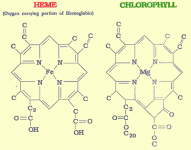Interesting article comparing the two.
https://science2be.wordpress.com/2012/09/03/the-amazing-similarity-between-blood-and-chlorophyll/
https://science2be.wordpress.com/2012/09/03/the-amazing-similarity-between-blood-and-chlorophyll/



